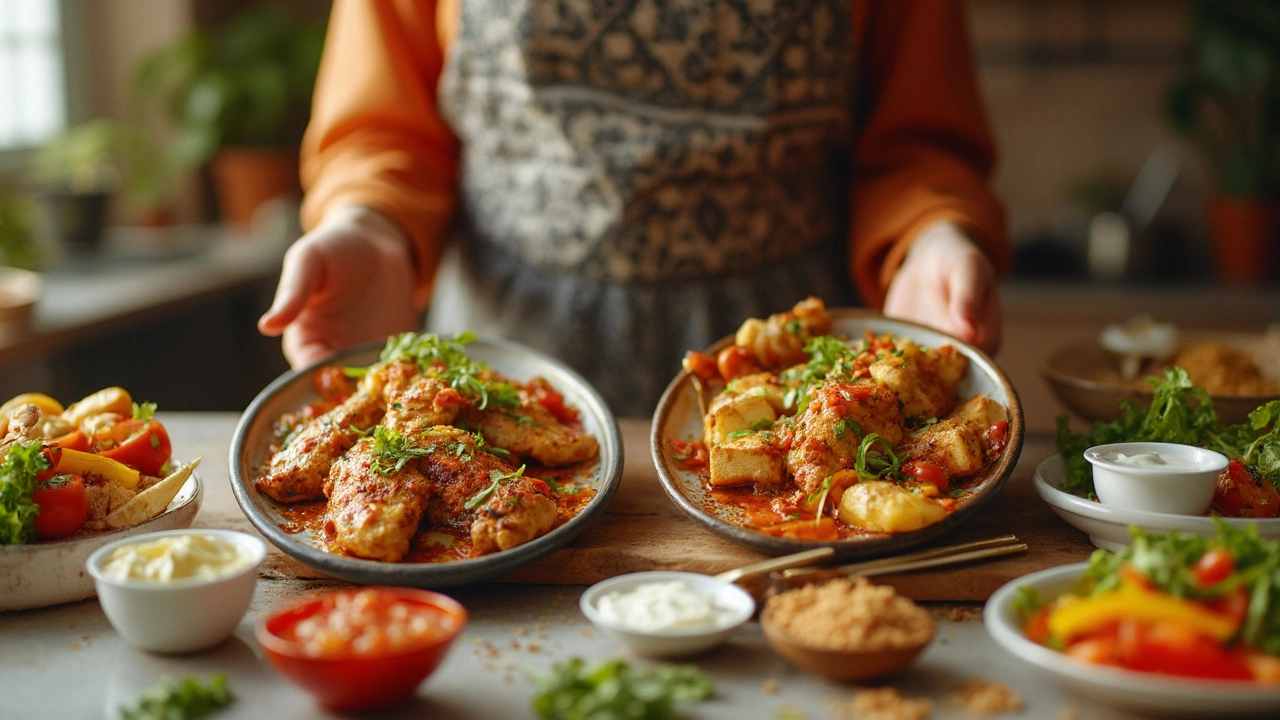Standing in front of the menu at your favorite Indian spot, you're stuck: tandoori or tikka? They look almost identical, both sizzling hot and bursting with color. But when it comes to health, what sets them apart?
The way these snacks are cooked might surprise you—they’re both roasted in a tandoor (that big, clay oven), but their recipes aren't twins. Tandoori usually means bone-in pieces, often marinated longer, paired with big, chunky veggies. Tikka, on the other hand, goes boneless, cut into smaller cubes for faster cooking and easy snacking. That difference in size and cut doesn’t just change the taste; it changes nutrition, too.
If you're watching your macros, tiny things can matter. That extra bit of skin on tandoori? It means a bump in fat and calories, especially when restaurants brush on melted butter or ghee before serving. Tikka is usually leaner, especially with chicken breast. But even then, sauces and dips can throw you off track if you're not careful.
Most people don’t realize how easy it is to make either one at home. Swap yogurt marinades for low-fat versions. Ask for less oil if you’re dining out. And here’s a tip: squeeze fresh lemon on top instead of dipping everything in heavy sauces. Trust me, your taste buds won’t miss a thing, and neither will your waistline.
- What Really Makes Tandoori and Tikka Different?
- Nutrition Showdown: Protein, Fat, and Calories
- Surprising Add-ons and Secret Ingredients
- Tips for Guilt-Free Indian Snacking
What Really Makes Tandoori and Tikka Different?
Let’s clear up the confusion: tandoori and tikka aren’t the same, even though both land in the tandoor oven and often star on the same menu. Here’s what actually sets them apart and why it matters for your plate.
Tandoori usually refers to whole pieces—think chicken legs, thighs, or even fish or paneer—marinated with yogurt, spices like cumin and coriander, and sometimes a dash of red food color for pop. These go straight into the piping-hot tandoor, bone-in and often with the skin on. Because tandoori uses larger cuts, the marination process goes deeper and the natural fat in the bones and skin sticks around after cooking. If you’ve seen those jumbo pieces with charred edges, you know you’re looking at tandoori.
Now, move to tikka. The big difference? Size and prep. "Tikka" literally means "bits" or "pieces." Here you get boneless, skinless cubes—mostly chicken breast, sometimes lamb or paneer—skewered and grilled fast. Tikka marinade is similar, but the smaller chunks soak up flavors quickly and cook more evenly. Tikka is also popular as a street food, served bite-sized for easy eating, while tandoori is often a sit-down, knife-and-fork affair.
- Tandoori: bone-in (usually), sometimes skin-on, big pieces, meat stays juicier from fat, slower cooking time
- Tikka: boneless, skinless, small cubes, leaner, cooks faster, often lower fat
What about flavor? Tandoori is smoky and deep, with the bone adding richness. Tikka gets its punchy taste from more surface area picking up the spices. But these tiny differences add up—especially if you’re making health choices.
| Tandoori Chicken | Chicken Tikka | |
|---|---|---|
| Cut | Bone-in, skin-on possible | Boneless, skinless pieces |
| Serving Style | Large, whole pieces | Small, bite-sized chunks |
| Marination Time | Longer (up to 24 hrs) | Shorter (1-4 hrs) |
| Cooking Time | Slower, to cook through bone | Faster, cooks evenly |
| Nutrition | More fat (skin, bone marrow) | Leaner, higher protein |
So, when you pick between tandoori and tikka, you’re actually choosing between whole cuts with extra fat and flavor, or lean cubes packed with protein and a slightly different spice hit. This basic difference is the starting point for making a smarter snack choice.
Nutrition Showdown: Protein, Fat, and Calories
Let’s cut to the chase: If you’re counting calories or tracking macros, you definitely want to know what makes tandoori and tikka different. Both are protein-packed, but there’s more going on under that spicy marinade.
Chicken tikka, typically made from boneless, skinless chicken breast, comes out as the leaner choice most of the time. For every 100 grams, chicken tikka averages around 120 to 140 calories, with about 4 to 5 grams of fat and a solid 22 grams of protein. All that protein fills you up without overloading your plate with extra calories.
Tandoori chicken sometimes keeps the skin and bone, which can change things. With the bone in and sometimes an extra brushing of oil or butter, those calories and fat grams creep up. One hundred grams of tandoori chicken could have closer to 150–170 calories and about 8 grams of fat, plus slightly less protein, since the bone adds weight but no protein value. Restaurants, especially, love to sneak in that extra fat for flavor.
| Item | Calories (per 100g) | Protein (g) | Fat (g) |
|---|---|---|---|
| Chicken Tikka | 130 | 22 | 5 |
| Tandoori Chicken | 160 | 20 | 8 |
Here’s a pro tip: Always ask if your tandoori or tikka is made with breast or thigh meat. Thigh is juicier but has more fat. While both dishes are way healthier than fried snacks, watch the marinades. Some chefs sneak in lots of ghee, cream, or mayonnaise (especially in colorful fusion tikkas). That “healthy Indian snack” can quickly turn calorie-dense if you’re not paying attention.
Want to make it even better for you? Skip the dips, or go for a simple yogurt chutney. Most calories sneak in when you’re not looking—think creamy mint sauces or that buttery naan you order on the side. If you really want a healthy Indian snack, stick to lean meat, minimal oil, and keep an eye out for any creamy add-ons.

Surprising Add-ons and Secret Ingredients
If you think a plate of tandoori or tikka is just meat and spices, you might be missing what goes on in the kitchen. Restaurants love to amp up flavors and juiciness with secret extras—some helpful, some not so much if you're aiming for a healthy snack.
The marinade is the first place you’ll spot surprises. Sure, yogurt, lemon juice, and signature Indian spices are basics, but a lot of cooks sneak in heavy cream or extra oil for richness. Tikka often stays lighter, especially if you use hung curd or a low-fat yogurt, while tandoori marinades can run heavier, especially for special versions (think: malai tikka or cheesy tandoori). Some street stalls even add food coloring for that dramatic red or yellow pop. Not a health worry by itself, but it adds nothing in terms of nutrition.
The way tandoori and tikka are finished also matters. Here’s the kicker: before serving, many restaurants brush the pieces with ghee (clarified butter) or melted butter to make everything glisten and stay moist. That tasty char? Sometimes it's because of the extra oil. At home, you can skip this step or use just a dab of olive oil spray instead.
Toppings and sides bring more hidden calories and fat. Most people dunk their bites in creamy mint chutney or go heavy on raita. Check the small print: these “sides” can easily double the calorie hit. And when there’s naan or paratha on the plate, you’re suddenly in meal territory, not snack-land.
- If you want to keep it light, ask for your tikka or tandoori without butter/oil basting.
- Go for citrus: a big squeeze of lemon brings out flavor without adding calories.
- Swap creamy dips for fresh salsa or plain yogurt mixed with herbs.
- Watch for "malai" or "paneer" versions—these often hide extra cream or cheese.
If you’re curious how much a difference the add-ons make, here’s a quick look at typical calorie bumps for the most common extras:
| Add-on | Calories per Tablespoon |
|---|---|
| Melted butter/ghee | 100 |
| Regular mint chutney | 35 |
| Raita | 40 |
| Malai (cream) | 52 |
It’s easy to see why paying attention to these small details helps keep healthy Indian snacks on the lighter side. The main dish is only half the story—the extras can pack a real punch if you’re not looking.
Tips for Guilt-Free Indian Snacking
If you’re hooked on tandoori or tikka, there’s no need to ditch these classics to keep things healthy. The secret lies in how you prep, cook, and even order them. Here are ways to keep your Indian snacking light but still packed with flavor:
- Go lean with your protein. Pick chicken breast or fish for tikka or tandoori—they’re both high in protein and low in fat. Lamb and paneer are tasty, but they up your calorie count fast.
- Skip the heavy sauces. Most calories sneak in with creamy dips like mayo or rich chutneys. Ask for sauces on the side, so you control the amount or swap them for fresh lemon or mint-coriander chutney (made with less oil).
- Watch out for add-ons. Melted butter or ghee is often brushed on tandoori right before serving. Ask for your order without the extra fat to save around 50-100 calories per serving.
- DIY-friendly marinade swaps. At home, use low-fat yogurt instead of cream in your marinade, and toss in spices like turmeric and cumin for flavor boosts without extra calories.
- Pair with the right sides. Skip the naan or deep-fried stuff—grilled veggies, a cabbage salad, or cucumber raita keep your snack plate light and fresh.
Here’s a quick look at how typical choices stack up:
| Snack | Protein (g) | Fat (g) | Calories |
|---|---|---|---|
| Chicken Tikka (100g) | 18 | 6 | 150 |
| Chicken Tandoori (100g, skinless) | 20 | 4 | 130 |
Finally, choose grilling or baking over frying. Even at restaurants, places that use a traditional clay oven (tandoor) usually use less oil than when things are pan-fried. If you control these little details, tandoori and tikka stay healthy, simple, and totally crave-worthy.
